A fun installment in the Magic TV series, from Channel Fireball online.
Find the original post here.
Monday, October 17, 2011
Horde Magic: Surviving the Zombie Apocalypse
From Wooberg.com.
Wooberg discusses a new, and very interesting Magic format called Horde Magic. A good piece, and a very interesting varation.
First of all, I have written my own slight variation on the rules to make the game more balanced. We STEAMROLLED the Zombie Horde almost every time we played, and while it was still fun, a little more of a chance that the zombies will win would have increased the amount of fun that was had.
Secondly, the horde deck that we played against tended to have less-than-epic turns as far as the amount of zombie tokens that flipped each turn. It tended to only flip 1-2 cards, and those cards were not so much more powerful than a token that they made the zombies' board state increase in power to any significant degree.
Some tips for making a good Horde deck:
Make sure all non-token cards are SIGNIFICANTLY more powerful than the average token: Rotting Fensnake didn't make the cut in my horde deck. I left those spaces open for things like Gluttonous Zombie or Tresserhorn Skyknight.
Needs more card advantage/recursion/answers: When the opponent cannot make decisions, finding good answers is tough. Fleshbag Marauder was in the sample Horde deck and makes the deck-without-a-pilot make a decision of which creature to sacrifice. I used cards like Living Death and Plague Wind to try and give the zombies more of an advantage. They effectively cannot do anything that is considered "the best" to do in magic. No card drawing, no "mana ramping"...Ghoulraiser is an important addition, because it gives the Horde a little recursion without targeting/causing a decision. I also considered Empty the Catacombs and may still add it at a later time.
You can see both the sample Horde deck and my horde deck on the Hoard Magic page here, don't get this format confused however with the Horde format from the Magic . People often name formats the same thing as others that haven't seen much play over the years and it makes cataloging them quite hard.
Wooberg discusses a new, and very interesting Magic format called Horde Magic. A good piece, and a very interesting varation.
I was recently introduced to a fun, if not all that balanced format called Horde Magic that was featured on Quiet Speculation recently. The format has a TON of potential and I wanted to share some of my thoughts with my readers.
First of all, I have written my own slight variation on the rules to make the game more balanced. We STEAMROLLED the Zombie Horde almost every time we played, and while it was still fun, a little more of a chance that the zombies will win would have increased the amount of fun that was had.
Secondly, the horde deck that we played against tended to have less-than-epic turns as far as the amount of zombie tokens that flipped each turn. It tended to only flip 1-2 cards, and those cards were not so much more powerful than a token that they made the zombies' board state increase in power to any significant degree.
Some tips for making a good Horde deck:
Make sure all non-token cards are SIGNIFICANTLY more powerful than the average token: Rotting Fensnake didn't make the cut in my horde deck. I left those spaces open for things like Gluttonous Zombie or Tresserhorn Skyknight.
Needs more card advantage/recursion/answers: When the opponent cannot make decisions, finding good answers is tough. Fleshbag Marauder was in the sample Horde deck and makes the deck-without-a-pilot make a decision of which creature to sacrifice. I used cards like Living Death and Plague Wind to try and give the zombies more of an advantage. They effectively cannot do anything that is considered "the best" to do in magic. No card drawing, no "mana ramping"...Ghoulraiser is an important addition, because it gives the Horde a little recursion without targeting/causing a decision. I also considered Empty the Catacombs and may still add it at a later time.
You can see both the sample Horde deck and my horde deck on the Hoard Magic page here, don't get this format confused however with the Horde format from the Magic . People often name formats the same thing as others that haven't seen much play over the years and it makes cataloging them quite hard.
Find the original post here.
A tribute to the International “Suit Up”-Day
From Completely Casual online.
I laughed out loud when I read this. I'm a big fan of How I Met Your Mother, and especially Barney Stinson, and this post perfectly defines a new segment I'd like to start, which celebrates the most obscure of holidays in the only way I know how: by linking them somehow to Magic. Enjoy, Hayden.
 In America, they still sit down with their shorts and reverse baseball caps to play Magic: the Gathering. The most “Suited Up” it gets in the American Magic community is when some girl puts on a Magic card dress at PAX – and is later denounced as a marketing scheme. Instead of mocking her, I believe it is rather time for the all-White-foils prom gown to go with her date’s tuxedo.
In America, they still sit down with their shorts and reverse baseball caps to play Magic: the Gathering. The most “Suited Up” it gets in the American Magic community is when some girl puts on a Magic card dress at PAX – and is later denounced as a marketing scheme. Instead of mocking her, I believe it is rather time for the all-White-foils prom gown to go with her date’s tuxedo.
Here in Europe, the Frenchman and long time Magic Professional, Raphael Levy, already showed us how that works. In 2008, at Pro Tour Berlin, Germany, he got 80 of the 454 participants to show up dressed in suits. Some even went all-in with neck tie and black shoes, as Wizard stated in their recap of the events. Raphael Levy explained his motivation to organize this “Suit Up” initiative in an interview with Brian David Marshal: “I can’t remember seeing a pro chess player wearing a baseball cap. I believe Magic needs a new face, and that could help. And it would indeed be awesome!”
 Because Magic got more and more players over the last half decade and still is not losing its growth in popularity, it is starting to raise attention in the mainstream. Do Magic players really want to be seen as those geeky guys who still live in their moms garage? I say: “Hell no!” Because it is not true. Rather, we are sophisticated guys, who will later become Hedge Fund Managers, like our icon Jon Finkel did, or will have, models as girlfriends, like former Magic player David Williams does (though David Williams got disqualified for cheating and went on to play poker instead. Not implying that cheating in Magic is actually a good thing). It has to be admitted that Finkel is not dating models, but rather a tech blog intern he met on a dating site, as we recently discovered.
Because Magic got more and more players over the last half decade and still is not losing its growth in popularity, it is starting to raise attention in the mainstream. Do Magic players really want to be seen as those geeky guys who still live in their moms garage? I say: “Hell no!” Because it is not true. Rather, we are sophisticated guys, who will later become Hedge Fund Managers, like our icon Jon Finkel did, or will have, models as girlfriends, like former Magic player David Williams does (though David Williams got disqualified for cheating and went on to play poker instead. Not implying that cheating in Magic is actually a good thing). It has to be admitted that Finkel is not dating models, but rather a tech blog intern he met on a dating site, as we recently discovered.
Raphael Levy explained his affinity for suits in the above mentioned interview: “The game suddenly looks more serious and professional when you sit down at the table and take off your jacket. Players look like gentlemen and not like kids anymore. Players in suits always have this kind of awe around them.” Even when playing in dart tournaments nowadays, you have to wear black long trousers and a jacket – a game normally played by fat dudes wearing sweat pants, after drinking a pitcher of beer at their local bar.
 I beg you, Wizards: It really is time to make the Pro Tour a black shoes and tie-only event. It is about time to “Suit Up!” Magic has become too popular not to (and to keep the geeky-ness, make an exception for cosplayers. We wouldn’t wanna miss the one guy playing at the local Modern Grand Prix dressed up as Jace, the Mind Sculptor. Better keeping the card banned instead of him).
I beg you, Wizards: It really is time to make the Pro Tour a black shoes and tie-only event. It is about time to “Suit Up!” Magic has become too popular not to (and to keep the geeky-ness, make an exception for cosplayers. We wouldn’t wanna miss the one guy playing at the local Modern Grand Prix dressed up as Jace, the Mind Sculptor. Better keeping the card banned instead of him).
Even if Wizards, as a company, does not force us to play better dressed in fear of driving people from attending, it is your responsibility as casual and competitive players to finally “Suit Up!” You do not have to show up in a tuxedo with a bow tie, but a shirt instead of the stained baby blue Jace T-shirt you got at the Worldwake pre-release. If you want to go a little fancier, while still wearing your fan shirt, you might find that it looks quite slick if you just put a jacket over it. Suddenly you evolve fashion wise from Lvl 1 Magic nerd to a Lvl 7 guy who wears a funky T-shirt for fun under his jacket. Regarding his intent to repeat future “Suit Up”-Pro Tours, Raphael Levy stated: “I have had that in mind, but let us first see what the ‘Private Pro Tours’ look like. Maybe they can be a good opportunity to do it again.” As Wizards had announced for 2012, Pro Tours will stop being open conventions for everyone and will start to become “Private”. What exactly that means, was not revealed until now. But it might be a good opportunity to become more “grown up” for Magic tournaments.
I am hoping Levy makes his promise come true. Now as Hipsters all around the globe are adapting the “Nerd Style”, with these black horn-rimmed spectacles and those checkered sweaters combined with Chucks, I believe it is time for us Nerds to move on. Who wants to be identified as a hipster? – I’d rather dodge that.
Find the original post here.
I laughed out loud when I read this. I'm a big fan of How I Met Your Mother, and especially Barney Stinson, and this post perfectly defines a new segment I'd like to start, which celebrates the most obscure of holidays in the only way I know how: by linking them somehow to Magic. Enjoy, Hayden.
Might it be time to finally “Magic-Suit Up”?
What better time is there to talk about this topic, than the International “Suit Up Day”, happening every 13. October. In America, they still sit down with their shorts and reverse baseball caps to play Magic: the Gathering. The most “Suited Up” it gets in the American Magic community is when some girl puts on a Magic card dress at PAX – and is later denounced as a marketing scheme. Instead of mocking her, I believe it is rather time for the all-White-foils prom gown to go with her date’s tuxedo.
In America, they still sit down with their shorts and reverse baseball caps to play Magic: the Gathering. The most “Suited Up” it gets in the American Magic community is when some girl puts on a Magic card dress at PAX – and is later denounced as a marketing scheme. Instead of mocking her, I believe it is rather time for the all-White-foils prom gown to go with her date’s tuxedo.Here in Europe, the Frenchman and long time Magic Professional, Raphael Levy, already showed us how that works. In 2008, at Pro Tour Berlin, Germany, he got 80 of the 454 participants to show up dressed in suits. Some even went all-in with neck tie and black shoes, as Wizard stated in their recap of the events. Raphael Levy explained his motivation to organize this “Suit Up” initiative in an interview with Brian David Marshal: “I can’t remember seeing a pro chess player wearing a baseball cap. I believe Magic needs a new face, and that could help. And it would indeed be awesome!”
 Because Magic got more and more players over the last half decade and still is not losing its growth in popularity, it is starting to raise attention in the mainstream. Do Magic players really want to be seen as those geeky guys who still live in their moms garage? I say: “Hell no!” Because it is not true. Rather, we are sophisticated guys, who will later become Hedge Fund Managers, like our icon Jon Finkel did, or will have, models as girlfriends, like former Magic player David Williams does (though David Williams got disqualified for cheating and went on to play poker instead. Not implying that cheating in Magic is actually a good thing). It has to be admitted that Finkel is not dating models, but rather a tech blog intern he met on a dating site, as we recently discovered.
Because Magic got more and more players over the last half decade and still is not losing its growth in popularity, it is starting to raise attention in the mainstream. Do Magic players really want to be seen as those geeky guys who still live in their moms garage? I say: “Hell no!” Because it is not true. Rather, we are sophisticated guys, who will later become Hedge Fund Managers, like our icon Jon Finkel did, or will have, models as girlfriends, like former Magic player David Williams does (though David Williams got disqualified for cheating and went on to play poker instead. Not implying that cheating in Magic is actually a good thing). It has to be admitted that Finkel is not dating models, but rather a tech blog intern he met on a dating site, as we recently discovered.Raphael Levy explained his affinity for suits in the above mentioned interview: “The game suddenly looks more serious and professional when you sit down at the table and take off your jacket. Players look like gentlemen and not like kids anymore. Players in suits always have this kind of awe around them.” Even when playing in dart tournaments nowadays, you have to wear black long trousers and a jacket – a game normally played by fat dudes wearing sweat pants, after drinking a pitcher of beer at their local bar.
 I beg you, Wizards: It really is time to make the Pro Tour a black shoes and tie-only event. It is about time to “Suit Up!” Magic has become too popular not to (and to keep the geeky-ness, make an exception for cosplayers. We wouldn’t wanna miss the one guy playing at the local Modern Grand Prix dressed up as Jace, the Mind Sculptor. Better keeping the card banned instead of him).
I beg you, Wizards: It really is time to make the Pro Tour a black shoes and tie-only event. It is about time to “Suit Up!” Magic has become too popular not to (and to keep the geeky-ness, make an exception for cosplayers. We wouldn’t wanna miss the one guy playing at the local Modern Grand Prix dressed up as Jace, the Mind Sculptor. Better keeping the card banned instead of him).Even if Wizards, as a company, does not force us to play better dressed in fear of driving people from attending, it is your responsibility as casual and competitive players to finally “Suit Up!” You do not have to show up in a tuxedo with a bow tie, but a shirt instead of the stained baby blue Jace T-shirt you got at the Worldwake pre-release. If you want to go a little fancier, while still wearing your fan shirt, you might find that it looks quite slick if you just put a jacket over it. Suddenly you evolve fashion wise from Lvl 1 Magic nerd to a Lvl 7 guy who wears a funky T-shirt for fun under his jacket. Regarding his intent to repeat future “Suit Up”-Pro Tours, Raphael Levy stated: “I have had that in mind, but let us first see what the ‘Private Pro Tours’ look like. Maybe they can be a good opportunity to do it again.” As Wizards had announced for 2012, Pro Tours will stop being open conventions for everyone and will start to become “Private”. What exactly that means, was not revealed until now. But it might be a good opportunity to become more “grown up” for Magic tournaments.
I am hoping Levy makes his promise come true. Now as Hipsters all around the globe are adapting the “Nerd Style”, with these black horn-rimmed spectacles and those checkered sweaters combined with Chucks, I believe it is time for us Nerds to move on. Who wants to be identified as a hipster? – I’d rather dodge that.
Find the original post here.
Packs going to $5?
This I'm sad to say is not mere speculation. Anyone who follows Magic the Gathering pricing trends has seen this coming. Notice: Innistrad booster boxes are around 10-15% more expensive then previous booster boxes. From speaking with folks I know who own businesses, their costs have been on the rise for the last 2 years. I'm sure we've only just seen the beginning of the coming price increases.
Modern to Replace Extended in 2012?
Here's a bit of interesting speculation from the MTGSalvation Forum: Modern will replace extended next year on the Pro Tour. I have to admit, Modern really excites me, far more then either Standard or Extended ever did. If this turns out to be true, you may see me competing on the Pro Tour in 2012!
New Version of Sorin to Appear in the Innistrad Block
I think the title of this post pretty much says it all. While this is still speculation, I think its safe to say it can be confirmed, and, the reprint of Sorin in M12 indicates the coming Sorin will be something entirely new. Cheers.
Humans in Standard
From the Command Zone.
Right now, I imagine the optimal Human deck to be Green/White, though mono-White certainly is well supported enough to be viable… however we’d be cutting off two really strong “Lords” in the form of Mayor of Avabruck and Hamlet Captain. Hamlet Captain is one of the principle reasons I’m even interested in building this deck, so I am not willing to lose Green… besides that, a Mono-White Human deck would be very much like a typical White Weenie deck, which is somewhat less exciting, as I’ve visited that archetype quite often over the years.
Let me preface this by saying this article is not intended or expected to produce a competitive Standard deck. I haven’t played Standard since Rafiq of the Many and the rest of the Bant Shard rotated out. But I don’t like to turn my back on 60-card Magic for too long, as I don’t want to let my 60-card deckbuilding skills atrophy too much. So at worst, this article might produce a deck that’s fun to play in the Casual room on MTGO or maybe, just MAYBE, good enough to make Top 8 at some local FNMs, but it’s not meant to be a serious deck.
Human is actually an extremely common creature type, but has never been officially supported as a true “Tribe” in that there were no cards that specifically referenced them in their ability text. No “Lord” creatures existed, nor other beneficial abilities to push players into playing Humans. Innistrad has changed all that, and quite drastically. There are plenty of Humans in Innistrad, of course, but plenty of cards with abilities that push you into playing Humans as a legitimate tribe. Some are great (Champion of the Parish) and some are not so great (Dearly Departed).
Right now, I imagine the optimal Human deck to be Green/White, though mono-White certainly is well supported enough to be viable… however we’d be cutting off two really strong “Lords” in the form of Mayor of Avabruck and Hamlet Captain. Hamlet Captain is one of the principle reasons I’m even interested in building this deck, so I am not willing to lose Green… besides that, a Mono-White Human deck would be very much like a typical White Weenie deck, which is somewhat less exciting, as I’ve visited that archetype quite often over the years.
Let’s take a look at which Humans are available to us in Standard, at least those that are the most playable. I’ll run these down by mana-cost, starting with one drops.
One Mana
Champion of the Parish – Easily the best one-drop we have access to, this should be an automatic 4x in any Human deck.
Elite Vanguard – Another fantastic, highly aggressive Human for a single W. Also a likely 4x.
Gideon’s Lawkeeper – Not as aggressive, but could be a good side-board option.
Avacyn’s Pilgrim – It might seem a bit odd to include a “mana elf” in a deck with such a low curve, but I think this should also be a 4x.
Two Mana
Accorder Paladin – Seems ideal here, as a very aggressive two-drop that also pumps the rest of your guys. Highly playable.
Elite Inquisitor – More of a sideboard card, if anything, but a 2/2 First Striker with Vigilance is still playable.
Grand Abolisher – Not quite aggro enough for the main deck, but a very valuable sideboard option.
Puresteel Paladin – Fantastic in the right deck, but I doubt he’ll have adequate support in this particular deck.
Hamlet Captain – Definitely a 4x, as it’s one of the main reasons I wanted to build this deck.
Mayor of Avabruck – Your other humans get +1/+1… seems like something we might want. It does kinda suck if he flips, but you should have little trouble dropping two guys in one turn to flip him back.
Skinshifter – This guy is tough, as I can’t figure out if I want 4x of him, or zero copies. Seems pretty solid.
Three Mana
Fiend Hunter – Tough call. It seems possible to maindeck this guy, but as a 1/3 for 3 he’d be the least aggro creature in the deck, probably. I’d say 4x sideboard, or a 2x main deck.
Gideon’s Avenger – I’m a big fan of this guy, but if you’re not running other tap effects (such as Gideon’s Lawkeeper) I’m not sure he’s worth it.
Mentor of the Meek – A must-have for this deck, as we’ll likely be dumping our hand quickly, and need to keep our grip full to apply pressure.
Mirran Crusader – Best with some Equipment such as Sword of War and Peace or whatever, but probably still great on his own.
Elder of Laurels – Might be a 2x in a more casual, slow version of the deck. Too expensive for my build, though.
Four Mana
Hero of Bladehold – There’s only one creature powerful enough to be worthwhile above three mana, and this is it. I would love to have 2x of these in the deck, if we can fit them. Note that if we do have Hero, Avacyn’s Pilgrim definitely starts to look necessary.
Variable Cost
Mikaeus, the Lunarch – Probably too slow and costly for a truly aggro deck, but a fine casual card nonetheless.
That pretty much sums up the best of what Humanity has to offer us, for now at least. There are a lot of options here, and there’s no way we can fit all of these cards into a single 60 card deck. But that’s okay, because it gives us room for variance and customization. You should be able to tune the list to suit your playgroup’s power level, and your own personal play preferences. If Elder of Laurels and Mikaeus the Lunarch excite you the most, you can easily play a slower more deliberate version of this deck. Throw in the Lawkeepers and Fiend Hunters to control the board while you build up to critical mass.
Or, you can just see how far you can push the aggro side, and make the deck as fast as possible.
4x Champion of the Parish
4x Elite Vanguard
3x Avacyn’s Pilgrim
4x Accorder Paladin
4x Hamlet Captain
3x Mayor of Avabruck
2x Skinshifter
3x Mirran Crusader
2x Mentor of the Meek
2x Hero of the Bladehold
3x Beast Within
4x Mutagenic Growth
4x Razorgrass Prairie
4x Sunpetal Grove
4x Forest
10x Plains
For the non-Creature spells, I chose the most generically useful spells I could find, as I have no idea what opposition this deck might encounter. Mutagenic Growth is basically the best Giant Growth variant in Standard right now, and Beast Within is a pretty universal answer to any problematic Creature, Planeswalker or other permanent type.
A suggested sideboard might include:
4x Fiend Hunter
4x Elite Inquisitor
4x Grand Abolisher
3x Celestial Purge
Or something like that. I dunno. Another really compelling option is to run Triumph of the Hordes. It’s an Infect card, yes, so it kinda seems out of place with zero Infect creatures, but I think it might be worth it for the surprise factor. It can really screw up combat math for an opponent, who is expecting you to attack their life total, not poison them out. It can just end a game out of nowhere just as your opponent is starting to stabilize and looks to be clogging up the ground for your attackers. You pretty much have to kill them in one attack if you do cast it, otherwise you basically just skipped that turn, but that’s the appeal of Triumph: that card usually does end the game upon resolution.
Find the original post here.
Swords of Schwing and Schwang - Musings & a Top 10
From the Crazy 99 Blog.
I’ve never had a huge amount of time for Equipment in Commander. Some is obviously great, others are occasionally helpful but, on the whole, it just seems like a lot of effort to turn things sideways with benefit and I’m pretty opposed to just throwing things out into the Red zone with only the hope of Step 4 happening (Yes, that’s the “Profit” step). Up until recently the only equipment ever I really played were Jitte, Greaves & Clamp.
A very strange part of Commander is discovering that 100 cards is, in fact, not really a lot when you get down to it. Take the pre-build count of your average Commander deck, that being the obligatory 100 cards; slice off 40-ish cards for land & mana rocks; add a general; now take the entire history of magic and condense it into the kind of deck you want to play in just 60 remaining card slots……. You now have a deck.
The obvious problem here is that, in those 60 card slots, there’s really only so much you can do. You have your criteria for the deck you want to build and that’s going to form the greater part of these slots. If Equipment isn’t an integral part of that strategy, you need to have a very good reason to make room for it.
A lot has to come together to get "value" from equipment: A creature, the equipment and, usually, a successful attack step. Bearing in mind that the equipment (artifact) and the creature involved are the two most gunned-after card types in the format and there's a whole table of guys worried that whatever scariness you've cobbled together is coming their way. This makes for a very hostile environment.
Probably the most played equipment in Commander is Lightning Greaves. It’s cheap, equips for free and grants two excellent abilities: Surprise and protection. The only-slightly-less-exciting version that M12 gave us, Swiftfoot Boots, trades off an additional 1-mana equip cost for the ability to interact with your own creature. I expect Lightning Greaves to stay top dog in the equipment stakes because general-centric decks really, really need to protect their general and "Das Boots" does this. (Amusing sidebar: Lightning Greaves has long been nicknamed “Das Boots” despite actually being a pair of greaves. Now that we actually have a functionally similar pair of boots, will we have to dub them “Das Greaves”?)
Past fancy footwear, equipment is either incredibly niche or exceedingly high on the cost/benefit scale. Some form of protection or evasion is a minimum requirement and triggered abilities or granting some sort of stat/keyword that’s outside the usual remit of your colors is the bar against which successful EDH equipment is gauged.
This leads to a very short list.
One of the inherent drawbacks associated with equipment, the congruence of all the favourable elements, was addressed with the Living Weapon mechanic in New Phyrexia. Suddenly you didn't have to make a guy and protect it while you played your Axe and paid to equip it. By giving you the token, weak as it may be, you're essentially making a mana saving of "X+Y" where "X" is the cost of the creature and "Y" is the cost of equipping the Living Weapon and a card saving of whatever creature you’d have attached the non-living weapon version to. Sure, the creature you're given is a 0/0 but even a 0/0 has it’s uses, including dying piteously should the situation require it, and it can still attack (all living weapons grant a toughness boost of at least +1). A 0/0 with +10/+10 is still a 10/10. While the initial popularity for Living Weapons seems to have tapered off, we are still left with 3 that are getting some serious play: Bonehoard, Lashwrithe & Batterskull; essentially a huge beater, a huge beater and a one-man army.
I have to admit that my main experience with equipment is Clamp, Greaves, Jitte and seeing small, cheap strength boosts, Banners and Jittes across the table in an aggressive deck or the occasional Sword in a 1v1 game but, on the whole, really nothing very overbearing.
Then I completed a trade that finally saw me getting my hands on a Sword of Fire and Ice and, about 2 days later, I cracked a Sword of War and Peace and thus completed the full set of Swords of One-thing and Something-Else. The only small issue was what to do with them now that I had them?
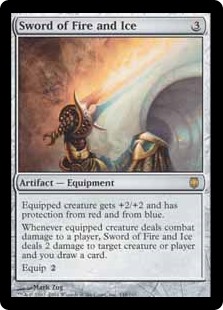 I initially thought about parceling them out between different decks or, possibly, constructing a new Voltron deck, though neither appealed to me all that much. In the end, time and utter laziness won over and I dropped them all into my Thada Adel deck, kicking out some of the less friendly artifact stuff. This was the only change I made to the deck overall so it was still theoretically a slow rolling artifact/control deck that can go big quick but generally turtles until it can swing some mid-game hay-makers and ride the tempo to victory. Needless to say, I didn’t expect the swords to make all that much difference to the deck as a whole.
I initially thought about parceling them out between different decks or, possibly, constructing a new Voltron deck, though neither appealed to me all that much. In the end, time and utter laziness won over and I dropped them all into my Thada Adel deck, kicking out some of the less friendly artifact stuff. This was the only change I made to the deck overall so it was still theoretically a slow rolling artifact/control deck that can go big quick but generally turtles until it can swing some mid-game hay-makers and ride the tempo to victory. Needless to say, I didn’t expect the swords to make all that much difference to the deck as a whole.
What I didn't realise was that just adding 5 swords (with the possibility of a couple more in copy-artifact effects) turned Thada into an aggressive show stopper and it's all on the sholders of to those 5 Swords.
Case in point: Yesterday playing a 4-man against Ghave Combo-Tokens, Sapling Good-Stuff and Glissa. A little explosiveness on my part allowed an early Consecrated Sphinx (backed up with Reliquary Tower) which survived a couple of turns around the table before getting killed. Its demise coincided with Ghave landing Aura Shards and destroying every non-land permanent I controlled. A couple of turns later, I passed my turn after landing a Myr Retriever and a Maze of Ith and possessing pretty much nothing else but a precarious life total and a large hand filled with land and spells that had nothing to do just at that time.
Oh, and a Sword of War and Peace.
I then eliminated one player in each of my next three attack phases with that lowly 1/1.
Here's how it happened:
 Ghave, after wrecking my board, fell low on life to a Massacre Wurm. Subsequent attack phases from Sapling and Glissa meant he would have perished before I untapped unless I saved him with my Maze of Ith, which I did.
Ghave, after wrecking my board, fell low on life to a Massacre Wurm. Subsequent attack phases from Sapling and Glissa meant he would have perished before I untapped unless I saved him with my Maze of Ith, which I did.
Leaving him on 1 life and no board to speak of allowed me to untap and drop the sword onto the mighty Myr gaining a boatload of life courtesy of a Reliquary Tower and the earlier Consecrated Sphinx and, most importantly eliminating the Aura Shards from the game. I played a Memory Jar and passed the turn
Neither Sapling nor Glissa had the power on the table to finish me off on their turns and the turn came back to me. I cracked the Jar, drew into Sword of Feast and Famine and, with it, hit Glissa for exactly 12, enough to kill him. I untapped my land and added a second Sword of War and Peace in the form of a Sculpting Steel and passed the turn, recovering my exiled hand from the Jar.
Sapling saw the writing on the wall with 17 damage heading his way and no means to block and conceded the game.
Mighty Myr carried the day (and the Swords) with a victory that was facilitated in large part by a lot of card drawing but truly unlocked by the Swords themselves.
The subsequent game went in a similar vein with Swords flying around between whoever could hold them and proving too much advantage in the red zone. With the level of search and recursion the deck has for artifacts anyway, adding 5 equipment has proven to be a very aggressive step for Thada allowing resources to be sandbagged elsewhere while all the relevant colored generals around the table worry about lowly merfolk swinging swords.
I think I’m revising my stance about Equipment in Commander…..
I don't usually do Top 10s but I thought I’d do one here to see what I could come up with. How do you balance cards that have hugely varying power-levels depending on the deck they are in? For example, Jitte is great in a creature-heavy build but doesn’t particularly suffer against creature decks ether so can go in any build that has enough creatures to support it, whereas a sword of the incorrect combination for your playgroup could end up being just a +2/+2 for your opponents' defenders to chump all day.
10. Lashwrithe/ Bonehoard
I put these up last because they are “only” Strength boosts. Both fail on evasion and suffer on cost but make up for it with the potential to go big. If your target creature has evasion already, that's half the battle. Bonehoard is slightly weaker because of the necessity of playing graveyard hate in Commander but Lashwrithe has a color drawback that restricts its use. Even Urborg, Tomb of Yawgmoth won't turn your General's color identity Black! I hesitated long about putting Loxodon Warhammer in here but, in the end, the Living Weapon aspect gives these the edge.
9. Sword of Body and Mind
8. Batterskull
7. Sword of Light and Shadow

Being the least useful of the swords in commander (from a triggered ability rather than a protection standpoint), Sword of Body and Mind scores low in the top 10. It’s just behind Batterskull that scores on both resilience and Lifelink keywords but possibly loses out on cost. If you don't have either a lot of available mana or some means to cheat on costs, you're probably looking at a Time-Walk in anything but the late game and, while it may gain you some life, it doesn’t grant any protection. Rounding out this section is the Sword of Light and Shadow: It gains very relevant protections but once again the abilities are not as impressive as the other Swords. The ability to put a better creature than a 2/2 wolf back into your hand and subsequently into play is what gives it the edge over its blue/green brother.
6. Sword of War and Peace
5. Sword of Fire and Ice
4. Skullclamp
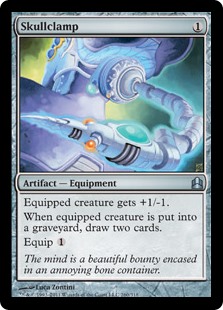 Putting Swords of War, Peace, Fire and Ice into the Top 10 is a no-brainer but they have to be edged out by much, much better equipment as they are either huge on the damage stakes or huge on the card- / board-advantage stakes.
Putting Swords of War, Peace, Fire and Ice into the Top 10 is a no-brainer but they have to be edged out by much, much better equipment as they are either huge on the damage stakes or huge on the card- / board-advantage stakes.
Here’s where it gets divisive: How do you relegate one of the most broken pieces of equipment to a mere 4th on the list of best Equipment in a format? An advantage to Skullclamp is that you don’t really need to build your deck around it to benefit. Once you have a decent creature count, it can do its thing peacefully enough because your creatures will die often during a game. Having a deck built specifically to takes advantage of ways to abuse it is why it got banned in the first place and it speaks of a power-level in Commander that’s extremely high. What could possibly beat one of the best and most controversial equipment ever to the top 3 spots?
Why, more "best" and "controversial" equipment, of course!!
3. Sword of Feast and Famine
2. Umezawa’s Jitte
1. Lightning Greaves
This is roughly where everyone looks at the number one and says: "Holy-Moley!! He put Greaves in first!!" Simply put, it's not on the same power level as most of the rest of the top 10 but it's so ubiquitous, efficient and useful that it's hard not to put it into every single Commander deck you build. It protects your commander, it allows you to grant scary beasties haste and is generally one of the most annoying permanents in the early- to mid-game.
Coming hot on the heels of Das Boots are Sword of Feast and Famine and Umezawa’s Jitte. The Sword has been the subject of quite a lot of attention in recent Standard due to the ease of finding it with Stoneforge Mystic. It enables "double" turns by allowing you to play spells in your pre-combat main phase, attack and untap to allow you to play more spells either during your post-combat main phase or your opponent's turn. You got your cake and you ate it.
Two very relevant protection colors added to this "double turn" ability make this sword just as potent in Commander as outside. The only small downside is the second triggered ability, discarding an opponent's card, can often actually facilitate his gameplan.
In compiling the list I had an issue not including things like Sunforger who’s restrictions are both color and build-based though, when you have those two combined, it’s very strong, arguably stronger than Bonehoard or Lashwrithe. Where do you think more specialised equipment like the Sunforger or, Loxodon Warhammer, Blade of the Bloodchief, Darksteel Plate, Swiftfoot Boots, Konda’s Banner, Nim Deathmantle, Skullclamp, Thornbite Staff & Umbral Mantle fit in on the list of top equipment?
Find the original post here.
I’ve never had a huge amount of time for Equipment in Commander. Some is obviously great, others are occasionally helpful but, on the whole, it just seems like a lot of effort to turn things sideways with benefit and I’m pretty opposed to just throwing things out into the Red zone with only the hope of Step 4 happening (Yes, that’s the “Profit” step). Up until recently the only equipment ever I really played were Jitte, Greaves & Clamp.
A very strange part of Commander is discovering that 100 cards is, in fact, not really a lot when you get down to it. Take the pre-build count of your average Commander deck, that being the obligatory 100 cards; slice off 40-ish cards for land & mana rocks; add a general; now take the entire history of magic and condense it into the kind of deck you want to play in just 60 remaining card slots……. You now have a deck.
The obvious problem here is that, in those 60 card slots, there’s really only so much you can do. You have your criteria for the deck you want to build and that’s going to form the greater part of these slots. If Equipment isn’t an integral part of that strategy, you need to have a very good reason to make room for it.
A lot has to come together to get "value" from equipment: A creature, the equipment and, usually, a successful attack step. Bearing in mind that the equipment (artifact) and the creature involved are the two most gunned-after card types in the format and there's a whole table of guys worried that whatever scariness you've cobbled together is coming their way. This makes for a very hostile environment.
Probably the most played equipment in Commander is Lightning Greaves. It’s cheap, equips for free and grants two excellent abilities: Surprise and protection. The only-slightly-less-exciting version that M12 gave us, Swiftfoot Boots, trades off an additional 1-mana equip cost for the ability to interact with your own creature. I expect Lightning Greaves to stay top dog in the equipment stakes because general-centric decks really, really need to protect their general and "Das Boots" does this. (Amusing sidebar: Lightning Greaves has long been nicknamed “Das Boots” despite actually being a pair of greaves. Now that we actually have a functionally similar pair of boots, will we have to dub them “Das Greaves”?)
Past fancy footwear, equipment is either incredibly niche or exceedingly high on the cost/benefit scale. Some form of protection or evasion is a minimum requirement and triggered abilities or granting some sort of stat/keyword that’s outside the usual remit of your colors is the bar against which successful EDH equipment is gauged.
This leads to a very short list.
One of the inherent drawbacks associated with equipment, the congruence of all the favourable elements, was addressed with the Living Weapon mechanic in New Phyrexia. Suddenly you didn't have to make a guy and protect it while you played your Axe and paid to equip it. By giving you the token, weak as it may be, you're essentially making a mana saving of "X+Y" where "X" is the cost of the creature and "Y" is the cost of equipping the Living Weapon and a card saving of whatever creature you’d have attached the non-living weapon version to. Sure, the creature you're given is a 0/0 but even a 0/0 has it’s uses, including dying piteously should the situation require it, and it can still attack (all living weapons grant a toughness boost of at least +1). A 0/0 with +10/+10 is still a 10/10. While the initial popularity for Living Weapons seems to have tapered off, we are still left with 3 that are getting some serious play: Bonehoard, Lashwrithe & Batterskull; essentially a huge beater, a huge beater and a one-man army.
I have to admit that my main experience with equipment is Clamp, Greaves, Jitte and seeing small, cheap strength boosts, Banners and Jittes across the table in an aggressive deck or the occasional Sword in a 1v1 game but, on the whole, really nothing very overbearing.
Then I completed a trade that finally saw me getting my hands on a Sword of Fire and Ice and, about 2 days later, I cracked a Sword of War and Peace and thus completed the full set of Swords of One-thing and Something-Else. The only small issue was what to do with them now that I had them?
What I didn't realise was that just adding 5 swords (with the possibility of a couple more in copy-artifact effects) turned Thada into an aggressive show stopper and it's all on the sholders of to those 5 Swords.
Case in point: Yesterday playing a 4-man against Ghave Combo-Tokens, Sapling Good-Stuff and Glissa. A little explosiveness on my part allowed an early Consecrated Sphinx (backed up with Reliquary Tower) which survived a couple of turns around the table before getting killed. Its demise coincided with Ghave landing Aura Shards and destroying every non-land permanent I controlled. A couple of turns later, I passed my turn after landing a Myr Retriever and a Maze of Ith and possessing pretty much nothing else but a precarious life total and a large hand filled with land and spells that had nothing to do just at that time.
Oh, and a Sword of War and Peace.
I then eliminated one player in each of my next three attack phases with that lowly 1/1.
Here's how it happened:
 Ghave, after wrecking my board, fell low on life to a Massacre Wurm. Subsequent attack phases from Sapling and Glissa meant he would have perished before I untapped unless I saved him with my Maze of Ith, which I did.
Ghave, after wrecking my board, fell low on life to a Massacre Wurm. Subsequent attack phases from Sapling and Glissa meant he would have perished before I untapped unless I saved him with my Maze of Ith, which I did.Leaving him on 1 life and no board to speak of allowed me to untap and drop the sword onto the mighty Myr gaining a boatload of life courtesy of a Reliquary Tower and the earlier Consecrated Sphinx and, most importantly eliminating the Aura Shards from the game. I played a Memory Jar and passed the turn
Neither Sapling nor Glissa had the power on the table to finish me off on their turns and the turn came back to me. I cracked the Jar, drew into Sword of Feast and Famine and, with it, hit Glissa for exactly 12, enough to kill him. I untapped my land and added a second Sword of War and Peace in the form of a Sculpting Steel and passed the turn, recovering my exiled hand from the Jar.
Sapling saw the writing on the wall with 17 damage heading his way and no means to block and conceded the game.
Mighty Myr carried the day (and the Swords) with a victory that was facilitated in large part by a lot of card drawing but truly unlocked by the Swords themselves.
The subsequent game went in a similar vein with Swords flying around between whoever could hold them and proving too much advantage in the red zone. With the level of search and recursion the deck has for artifacts anyway, adding 5 equipment has proven to be a very aggressive step for Thada allowing resources to be sandbagged elsewhere while all the relevant colored generals around the table worry about lowly merfolk swinging swords.
I think I’m revising my stance about Equipment in Commander…..
I don't usually do Top 10s but I thought I’d do one here to see what I could come up with. How do you balance cards that have hugely varying power-levels depending on the deck they are in? For example, Jitte is great in a creature-heavy build but doesn’t particularly suffer against creature decks ether so can go in any build that has enough creatures to support it, whereas a sword of the incorrect combination for your playgroup could end up being just a +2/+2 for your opponents' defenders to chump all day.
10. Lashwrithe/ Bonehoard
I put these up last because they are “only” Strength boosts. Both fail on evasion and suffer on cost but make up for it with the potential to go big. If your target creature has evasion already, that's half the battle. Bonehoard is slightly weaker because of the necessity of playing graveyard hate in Commander but Lashwrithe has a color drawback that restricts its use. Even Urborg, Tomb of Yawgmoth won't turn your General's color identity Black! I hesitated long about putting Loxodon Warhammer in here but, in the end, the Living Weapon aspect gives these the edge.
9. Sword of Body and Mind
8. Batterskull
7. Sword of Light and Shadow
Being the least useful of the swords in commander (from a triggered ability rather than a protection standpoint), Sword of Body and Mind scores low in the top 10. It’s just behind Batterskull that scores on both resilience and Lifelink keywords but possibly loses out on cost. If you don't have either a lot of available mana or some means to cheat on costs, you're probably looking at a Time-Walk in anything but the late game and, while it may gain you some life, it doesn’t grant any protection. Rounding out this section is the Sword of Light and Shadow: It gains very relevant protections but once again the abilities are not as impressive as the other Swords. The ability to put a better creature than a 2/2 wolf back into your hand and subsequently into play is what gives it the edge over its blue/green brother.
6. Sword of War and Peace
5. Sword of Fire and Ice
4. Skullclamp
Here’s where it gets divisive: How do you relegate one of the most broken pieces of equipment to a mere 4th on the list of best Equipment in a format? An advantage to Skullclamp is that you don’t really need to build your deck around it to benefit. Once you have a decent creature count, it can do its thing peacefully enough because your creatures will die often during a game. Having a deck built specifically to takes advantage of ways to abuse it is why it got banned in the first place and it speaks of a power-level in Commander that’s extremely high. What could possibly beat one of the best and most controversial equipment ever to the top 3 spots?
Why, more "best" and "controversial" equipment, of course!!
3. Sword of Feast and Famine
2. Umezawa’s Jitte
1. Lightning Greaves
This is roughly where everyone looks at the number one and says: "Holy-Moley!! He put Greaves in first!!" Simply put, it's not on the same power level as most of the rest of the top 10 but it's so ubiquitous, efficient and useful that it's hard not to put it into every single Commander deck you build. It protects your commander, it allows you to grant scary beasties haste and is generally one of the most annoying permanents in the early- to mid-game.
Two very relevant protection colors added to this "double turn" ability make this sword just as potent in Commander as outside. The only small downside is the second triggered ability, discarding an opponent's card, can often actually facilitate his gameplan.
In compiling the list I had an issue not including things like Sunforger who’s restrictions are both color and build-based though, when you have those two combined, it’s very strong, arguably stronger than Bonehoard or Lashwrithe. Where do you think more specialised equipment like the Sunforger or, Loxodon Warhammer, Blade of the Bloodchief, Darksteel Plate, Swiftfoot Boots, Konda’s Banner, Nim Deathmantle, Skullclamp, Thornbite Staff & Umbral Mantle fit in on the list of top equipment?
Find the original post here.
Computer Troubles.....
Sorry for the lack of posts recently, but I've been having some computer problems...expect us to be up and running again soon. Cheers, Hayden.
Saturday, October 8, 2011
Thoughts from the Wanderer
So I had a very interesting experience yesterday....bought 3 packs of Innistrad, the first 3 I've gotten actually, and pulled Liliana of the Veil out of one of them. And you know what I did with it? I went back into the store and traded her in. I got a very fair price for the card yes, but I think I was a bit hasty and actually kind of regret the situation. I wish I'd hung on to the card.

Granted, I know she's pretty close to, if not right at, her peak price, but there's something about having such a sought after card in my collection. Oh well, as they say, who is John Galt? Cheers.

Granted, I know she's pretty close to, if not right at, her peak price, but there's something about having such a sought after card in my collection. Oh well, as they say, who is John Galt? Cheers.
Thursday, October 6, 2011
New Planeswalkers coming in "Roll"
We have a bit of confirmed rumorings that indicate there will be two new Planeswalkers in the third set of the Innistrad block (code named "Roll"). The early betting is on Dack Fayden, though Ral Zarek is also a possibility.
Tuesday, October 4, 2011
Forgotten CCG of the mid-90s part 2: Ani-Mayhem!
Does anyone remember the 90s CCG Ani-Mayhem?
Just the other day I stumbled across a box full of Ani-Mayhem cards in my garage. Back during the infamous CCG Boom ('94-'96), games like this were everywhere. In '97, most of the games would go out of print thanks to the collapse of many of the companies that made them. Ani-Mayhem, while not a bad game, fell victim to such a collapse. Card stores and hobby shops couldn't get rid of their stock to save their lives.
Long story short, I got a ton of packs for next to nothing, and I still have them all.

Ani-Mayhem, like I said, was really not a bad game. Comparatively speaking, it was aweful (there were many CCGs that also went out of print that were vastly better), but then again, it was still an easy to play CCG, which made it better then alot of non-CCG games.
The basic objective of the game was to use your characters to search locations for treasure, all the while avoiding the "Disasters" hidden at each location.



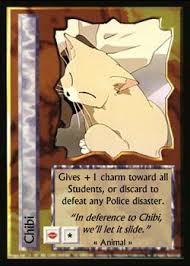
Again, the game was really not bad. It was very amusing, and if you were a fan of the animes covered by the game, it was fun to collect. The sad part about the company that printed Ani-Mayhem going belly-up was that the game was really just getting started. The Dragonball Z expansion, which was the first and only expansion, was actually pretty popular and gave the game a noticeable boost in popularity.
While I wouldn't recommend Ani-Mayhem for most people, it was still one of the higher points of the CCG Boom, and worth remembering. Cheers.
Just the other day I stumbled across a box full of Ani-Mayhem cards in my garage. Back during the infamous CCG Boom ('94-'96), games like this were everywhere. In '97, most of the games would go out of print thanks to the collapse of many of the companies that made them. Ani-Mayhem, while not a bad game, fell victim to such a collapse. Card stores and hobby shops couldn't get rid of their stock to save their lives.
Long story short, I got a ton of packs for next to nothing, and I still have them all.

Ani-Mayhem, like I said, was really not a bad game. Comparatively speaking, it was aweful (there were many CCGs that also went out of print that were vastly better), but then again, it was still an easy to play CCG, which made it better then alot of non-CCG games.
The basic objective of the game was to use your characters to search locations for treasure, all the while avoiding the "Disasters" hidden at each location.
Again, the game was really not bad. It was very amusing, and if you were a fan of the animes covered by the game, it was fun to collect. The sad part about the company that printed Ani-Mayhem going belly-up was that the game was really just getting started. The Dragonball Z expansion, which was the first and only expansion, was actually pretty popular and gave the game a noticeable boost in popularity.
While I wouldn't recommend Ani-Mayhem for most people, it was still one of the higher points of the CCG Boom, and worth remembering. Cheers.
Speaking of returning to previously used planes...
Speculation on the MTGSalvation Forum indicates that there will never be a return to Kamigawa.

I for one say, good riddance!

I for one say, good riddance!
Speculation of the Day: Ral Zarek
I'm sure most of you have seen this already:

Ral Zarek is apparently an unused planeswalker who was discovered in the Duel of the Planeswalkers 2012 game files. There is a screen shot with the above artwork, though the card itself was found elsewhere, and looks quite real. Apparently Ral is from Ravnica, further suggesting that a return to Ravnica may be coming.

Ral Zarek is apparently an unused planeswalker who was discovered in the Duel of the Planeswalkers 2012 game files. There is a screen shot with the above artwork, though the card itself was found elsewhere, and looks quite real. Apparently Ral is from Ravnica, further suggesting that a return to Ravnica may be coming.
Should there be more cards banned in MtG: Commander?
From Completely Casual.
Not only did Magic: the Gathering become wildly successful over the last few years since Hasbro took over and unleashed their marketing guys upon the brand; their marketing research showed that the broad audience of Magic players were those Kitchen Table Guys nobody ever payed attention to in the old days. Now not only do we have highly sought after mythic rares to tickle our inner child – sorry, have to correct myself there – inner Spike, but growing numbers of players all around the Multiverse. Most of these players are of the well known Kitchen Table Guy variety, and that is part of why alternative formats are on the rise. Of these formats, their poster child is EDH, now called Commander, holding the banner up high. So as the format becomes more and more played, there is one inevitable conclusion: it will become more competitive. Now people like me, who are casual players at heart, are asking themselves one big question:

The most important thing we have to consider in my opinion is the first principle of MtG: Commander as stated by the Rules Committee. It is known as the “rule of social interaction” and is stated on their official homepage right above the “official” (at least as official that can get when you abide the following principal) banned list:
 I think this is in theory totally the right mindset to have when playing Commander. I wrote an article some months ago, upholding this principle and reasoning why it is valid. And a second one on how to get those offending the social contract to change. But still I believe this does not legitimize the fact that certain cards remain unbanned. Further bannings may seem rather unnecessary if you and your playgroup follow the first MtG: Commander Principle, but this fundamental principle is already undermined by the simple existence of a banned list. Despite the fact that this list is only ‘semi-official’, it is backed by the authority of the Rules Committee and the most widely accepted set of guidelines followed by most Magic players all over the Multiverse. Many build their decks with this list in mind to ensure wider acceptance among their Magic peers, or when playing with strangers. Having this kind of authority to enforce an accepted banned list and telling us to follow the “social principle” would be strangely idealistic, but fine. Instead they sneak in this ‘semi-official’ banned list, therefore betray their very own first principle of MtG:Commander.
I think this is in theory totally the right mindset to have when playing Commander. I wrote an article some months ago, upholding this principle and reasoning why it is valid. And a second one on how to get those offending the social contract to change. But still I believe this does not legitimize the fact that certain cards remain unbanned. Further bannings may seem rather unnecessary if you and your playgroup follow the first MtG: Commander Principle, but this fundamental principle is already undermined by the simple existence of a banned list. Despite the fact that this list is only ‘semi-official’, it is backed by the authority of the Rules Committee and the most widely accepted set of guidelines followed by most Magic players all over the Multiverse. Many build their decks with this list in mind to ensure wider acceptance among their Magic peers, or when playing with strangers. Having this kind of authority to enforce an accepted banned list and telling us to follow the “social principle” would be strangely idealistic, but fine. Instead they sneak in this ‘semi-official’ banned list, therefore betray their very own first principle of MtG:Commander.
My conclusion on this matter is that if this social contract could work without the semi-official banned list, we would not have a semi-official banned list in the first place.
 Believing in the necessity of a banned list, I of course see that there should be as few cards banned as possible, while still believing that the first principle will take care of the minor glitches. Bans cannot be applied to every abusive combo or douschebaggery, as douschebaggery cannot be attributed to a card on its own, but rather on the collective deck – which finally is the responsibility of the piloting player. Maybe excluding Emrakul, the Aeons Torn, every card currently on the banned list could be used in different decks without a broken or unfun outcome. This is where the the First Principle and the Banned List meet eye to eye and have to find a compromise. I know that the solution cannot be banning every half-decent combo or removing every card from the format which annoys a specific portion of the player base without creating a list that overshoots its mark.
Believing in the necessity of a banned list, I of course see that there should be as few cards banned as possible, while still believing that the first principle will take care of the minor glitches. Bans cannot be applied to every abusive combo or douschebaggery, as douschebaggery cannot be attributed to a card on its own, but rather on the collective deck – which finally is the responsibility of the piloting player. Maybe excluding Emrakul, the Aeons Torn, every card currently on the banned list could be used in different decks without a broken or unfun outcome. This is where the the First Principle and the Banned List meet eye to eye and have to find a compromise. I know that the solution cannot be banning every half-decent combo or removing every card from the format which annoys a specific portion of the player base without creating a list that overshoots its mark.
 But there is one kind of card category that makes decks focused on abusive combos even better. Their exclusion from the format would not harm any casual players strategy – the only thing hurt would be some player’s nostalgic feelings towards MtG: Commander. The power these cards yield to an abusive or offensive deck is not limited to a certain combo or deck archetype, but instead makes every already uncasual abusive deck even better – if not outright broken. The kind of cards I believe should be banned in MtG: Commander are:
But there is one kind of card category that makes decks focused on abusive combos even better. Their exclusion from the format would not harm any casual players strategy – the only thing hurt would be some player’s nostalgic feelings towards MtG: Commander. The power these cards yield to an abusive or offensive deck is not limited to a certain combo or deck archetype, but instead makes every already uncasual abusive deck even better – if not outright broken. The kind of cards I believe should be banned in MtG: Commander are:
 The problem with most decks that are considered unfun in MtG: Commander and are hated by most casual players are decks which try to assemble a certain kind of unstoppable strategy as fast as possible. Either these decks create some kind of really fast prison lock or assemble their proven win-combo turn 4 or five – some of them even sooner, and reliably. The only way to enable this kind of speed are overpowered mana acceleration cards. Most of these cards are known for their power in Vintage and Legacy and are without a doubt candidates for their respective banned and restricted lists. As mentioned before, most of these cards are associated with a feeling of nostalgia for a lot of long time “Elder Dragon Highlander” players. Nevertheless, these cards are proving to be unhealthy for the format more and more each day. The following cards have been known for their power to enable crazy first or second turn starts for a long time now. Among their most famous recidivists are (sorted by power level):
The problem with most decks that are considered unfun in MtG: Commander and are hated by most casual players are decks which try to assemble a certain kind of unstoppable strategy as fast as possible. Either these decks create some kind of really fast prison lock or assemble their proven win-combo turn 4 or five – some of them even sooner, and reliably. The only way to enable this kind of speed are overpowered mana acceleration cards. Most of these cards are known for their power in Vintage and Legacy and are without a doubt candidates for their respective banned and restricted lists. As mentioned before, most of these cards are associated with a feeling of nostalgia for a lot of long time “Elder Dragon Highlander” players. Nevertheless, these cards are proving to be unhealthy for the format more and more each day. The following cards have been known for their power to enable crazy first or second turn starts for a long time now. Among their most famous recidivists are (sorted by power level):
These cards might not be reliable enough to guarantee game-breaking starts in a singleton format in every game, but seem to do it every other game. Also when combined with other decent acceleration, it collectively takes these kind of decks over the top, reliably, in every game. I understand the fondness a lot of casual players have grown for their lovely Sol Rings, especially if they are premium foil, custom altered Judge Foils. But without a doubt these cards only remain in the format for one single reason from my perspective: the affection casual players have devoted to the fact that they own cards that cannot be played in any other format except for Vintage – which sadly has an entry barrier of about 3000 bucks and might not considered casual enough for most of them (compared to Commander where you can start with as little as $40).
 Many argue that Sol Ring should be banned for the fact that you cannot build a deck in Commander without including one, as it is a staple alongside with Sensei’s Divining Top and Maze of Ith. While I believe Sol Ring should be banned, I totally disagree with anybody using this sort of reasoning. Although it might be true that many people have never built a Commander deck without including Sensei’s Divining Top, this has never been an issue or problem for the format. (Also I do not believe in the Top beeing a staple anyways.) While some people might feel bored by the obvious card choices their opponents make, most colors or even color combinations yield a similar problem, as they have certain staple cards of their own. While one can never remove the existence of “Staple Cards”, they only ever become
Many argue that Sol Ring should be banned for the fact that you cannot build a deck in Commander without including one, as it is a staple alongside with Sensei’s Divining Top and Maze of Ith. While I believe Sol Ring should be banned, I totally disagree with anybody using this sort of reasoning. Although it might be true that many people have never built a Commander deck without including Sensei’s Divining Top, this has never been an issue or problem for the format. (Also I do not believe in the Top beeing a staple anyways.) While some people might feel bored by the obvious card choices their opponents make, most colors or even color combinations yield a similar problem, as they have certain staple cards of their own. While one can never remove the existence of “Staple Cards”, they only ever become 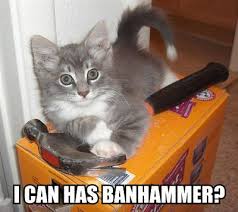 omnipresent when they are artifacts. This should not be viewed as a problem and cause a banning. One banned staple will just be replaced by its next best successor to become the new benchmark – the new staple.I only vouch for Sol Ring to be banned, as much as I vouch to ban the other cards on the list (and other similar offenders I might have missed) for their enhancement of decks which are all-powerful already. Though only giving a marginal advantage to the average deck, that wasn’t built to be abusive. While any casual deck will of cause be better off with a Sol Ring, it doesn’t miss much by not having it – except for invoking a nostalgic feeling for its pilot. An abusive deck on the other hand, can profit immensely by including cards like this to create a head start in the game to lock others out of it, or to end before it ever began. I understand the well established argument that there are enough answers to any given problem in Magic, even to fast mana, but sometimes these answers are not fast enough (Yes, this pun is pure irony!).
omnipresent when they are artifacts. This should not be viewed as a problem and cause a banning. One banned staple will just be replaced by its next best successor to become the new benchmark – the new staple.I only vouch for Sol Ring to be banned, as much as I vouch to ban the other cards on the list (and other similar offenders I might have missed) for their enhancement of decks which are all-powerful already. Though only giving a marginal advantage to the average deck, that wasn’t built to be abusive. While any casual deck will of cause be better off with a Sol Ring, it doesn’t miss much by not having it – except for invoking a nostalgic feeling for its pilot. An abusive deck on the other hand, can profit immensely by including cards like this to create a head start in the game to lock others out of it, or to end before it ever began. I understand the well established argument that there are enough answers to any given problem in Magic, even to fast mana, but sometimes these answers are not fast enough (Yes, this pun is pure irony!).
Putting this behind, there are no other cards which have to be banned immediately in MtG: Commander, in my view. This only leaves us with one card category worth putting on the Watch List. As I see it, these cards are problematic to casual Magic in general:
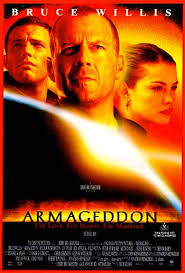 A lot of cards traditionally used to destroy lands, like Violent Ultimatum, Pillage or even Smokestack, can be used with an inoffensive intent, if you built your deck accordingly. Mass land destruction cards like Armageddon are one kind of card that only has two outcomes. Outcome one: You have put some relevant threats on the board by turn 4+, while your opponents for various reasons don’t (maybe they got theirs destroyed in some way or they are having a slow start). Now you drop an Armageddon on the board and your play group has to decide to show you some form of Counterspell or scoop up their cards to get another game started. Even if somebody is able to handle your threats in response, it only has an outcome equal to outcome two: any kind of board state where nobody has any real threats and somebody cycles an unanswered Decree of Annihilation (as Stifle isn’t really that much of a staple in Commander). Now you have to sit through a dreadful game waiting for somebody to finally topdeck enough mana to play an Eternal Witness or something to start bashing face for an amazing two damage for the next six turns, until he finally gets enough mana to play a decent threat. By that time, probably half the players have already scooped because of boredom – or left their cards at the table to get snacks, having instructed their opponents to flip their top card and play all the lands, as their cheapest spell in hand is a five drop.
A lot of cards traditionally used to destroy lands, like Violent Ultimatum, Pillage or even Smokestack, can be used with an inoffensive intent, if you built your deck accordingly. Mass land destruction cards like Armageddon are one kind of card that only has two outcomes. Outcome one: You have put some relevant threats on the board by turn 4+, while your opponents for various reasons don’t (maybe they got theirs destroyed in some way or they are having a slow start). Now you drop an Armageddon on the board and your play group has to decide to show you some form of Counterspell or scoop up their cards to get another game started. Even if somebody is able to handle your threats in response, it only has an outcome equal to outcome two: any kind of board state where nobody has any real threats and somebody cycles an unanswered Decree of Annihilation (as Stifle isn’t really that much of a staple in Commander). Now you have to sit through a dreadful game waiting for somebody to finally topdeck enough mana to play an Eternal Witness or something to start bashing face for an amazing two damage for the next six turns, until he finally gets enough mana to play a decent threat. By that time, probably half the players have already scooped because of boredom – or left their cards at the table to get snacks, having instructed their opponents to flip their top card and play all the lands, as their cheapest spell in hand is a five drop.
 While other cards can and often are used to induce grief if played in the right manner, I see no possible alternative way to play a mass land destruction spell without keeping the other players at the table from having fun. We all know that mana denial is the most unpopular threat to play against, so how can undiscriminated mana denial be considered fun? As having fun is often described as the essence of “Casual Magic the Gathering TM”, I believe, that all mass land destruction effects must be put on the watch list immediately and probably should receive the ban-hammer, ultimately.
While other cards can and often are used to induce grief if played in the right manner, I see no possible alternative way to play a mass land destruction spell without keeping the other players at the table from having fun. We all know that mana denial is the most unpopular threat to play against, so how can undiscriminated mana denial be considered fun? As having fun is often described as the essence of “Casual Magic the Gathering TM”, I believe, that all mass land destruction effects must be put on the watch list immediately and probably should receive the ban-hammer, ultimately.
 land sweeper. While these problems could also solved by a social contract, I do not fully believe in its functionality as a gentleman’s agreement (and neither, it seems, do the Rules Committee).While I believe that a gentleman’s agreement is a great way to deal with single cases, we have to follow a general set of laws and rules. The same way Wizards tries to make Magic’s rules create a certain experience, the EDH Rules Committee should try to emulate the way most casual people play EDH, by adjusting its rules and ban lists accordingly. In a democratic nation, laws are in general not passed so people follow them, but rather to represent and reflect the societies overall accepted moral standards. This does raise the question: why does the Rules Committee not follow the same principle? And I will tell you why – because it is hard work!
land sweeper. While these problems could also solved by a social contract, I do not fully believe in its functionality as a gentleman’s agreement (and neither, it seems, do the Rules Committee).While I believe that a gentleman’s agreement is a great way to deal with single cases, we have to follow a general set of laws and rules. The same way Wizards tries to make Magic’s rules create a certain experience, the EDH Rules Committee should try to emulate the way most casual people play EDH, by adjusting its rules and ban lists accordingly. In a democratic nation, laws are in general not passed so people follow them, but rather to represent and reflect the societies overall accepted moral standards. This does raise the question: why does the Rules Committee not follow the same principle? And I will tell you why – because it is hard work!
I don’t want to call them lazy or anything, but sometimes in life you have to step up your game. Now as Commander is getting more and more popular every day, it finally might be time to realize that they have a higher responsibility than in the good old days when people were still confused by “this strange Magic variant” all the Judges played in their downtime. But let us not jump to a fast conclusion, as I heard some rumors that they are actually working on some rules adjustments, that are still in testing. My first guess was that these changes, if there were any, would be announced with the release of the new MtG: Commander product from Wizards, this June. But as it seems we have to wait a little longer, if it ever comes.
Find the original post here.
Not only did Magic: the Gathering become wildly successful over the last few years since Hasbro took over and unleashed their marketing guys upon the brand; their marketing research showed that the broad audience of Magic players were those Kitchen Table Guys nobody ever payed attention to in the old days. Now not only do we have highly sought after mythic rares to tickle our inner child – sorry, have to correct myself there – inner Spike, but growing numbers of players all around the Multiverse. Most of these players are of the well known Kitchen Table Guy variety, and that is part of why alternative formats are on the rise. Of these formats, their poster child is EDH, now called Commander, holding the banner up high. So as the format becomes more and more played, there is one inevitable conclusion: it will become more competitive. Now people like me, who are casual players at heart, are asking themselves one big question:
Do we have to ban more cards to keep everything in check?
If you want to hear another oppinion on this matter, follow this link to hear what my buddy Andy from Commandercast has to say about this topic. And realize how far two members of the Casual Inquisition can disagree about this.
The most important thing we have to consider in my opinion is the first principle of MtG: Commander as stated by the Rules Committee. It is known as the “rule of social interaction” and is stated on their official homepage right above the “official” (at least as official that can get when you abide the following principal) banned list:
“[Commander] is founded (and dependent) on a social contract, otherwise known as a gentleman’s agreement. Unsporting conduct (whether extreme or simply “being a jerk”) should not be tolerated by players. Refusing to play with antisocial persons is the fastest way to better EDH community.However, because players have varied opinions of what constitutes fair and/or fun play, a recommended banned list is maintained to help guide players towards a good social experience. House rules or “fair play” exceptions are always encouraged if they result in more fun for the local community.”See the current MtG:Commander banned list here <—
My conclusion on this matter is that if this social contract could work without the semi-official banned list, we would not have a semi-official banned list in the first place.
High-end mana accelerators.
These cards might not be reliable enough to guarantee game-breaking starts in a singleton format in every game, but seem to do it every other game. Also when combined with other decent acceleration, it collectively takes these kind of decks over the top, reliably, in every game. I understand the fondness a lot of casual players have grown for their lovely Sol Rings, especially if they are premium foil, custom altered Judge Foils. But without a doubt these cards only remain in the format for one single reason from my perspective: the affection casual players have devoted to the fact that they own cards that cannot be played in any other format except for Vintage – which sadly has an entry barrier of about 3000 bucks and might not considered casual enough for most of them (compared to Commander where you can start with as little as $40).
A master of time never runs, he simply walks.
Putting this behind, there are no other cards which have to be banned immediately in MtG: Commander, in my view. This only leaves us with one card category worth putting on the Watch List. As I see it, these cards are problematic to casual Magic in general:
Mass land destruction.
Not this Armageddon
Concluding
Banning single combo pieces that annoy people might seem like the obvious choice, I would rather vouch the Commander community to take another approach. Instead of taking that route, we should consider thinking about the stuff that really makes games unfun. While there will always be annoying combos, there might be an underlying cause me might be missing, while we whine about those. I’m not saying that my presented approach is perfect or universal, I’m just pointing out things I dislike about Commander and search for the underlying cause of ruined games. While I don’t like abusive combos, it is mainly the fast mana that enables them to be all prominent and sometimes unstoppable. Also I dislike games that either lock you out of them or leave you with nothing to do, something that always happens when somebody plays aI don’t want to call them lazy or anything, but sometimes in life you have to step up your game. Now as Commander is getting more and more popular every day, it finally might be time to realize that they have a higher responsibility than in the good old days when people were still confused by “this strange Magic variant” all the Judges played in their downtime. But let us not jump to a fast conclusion, as I heard some rumors that they are actually working on some rules adjustments, that are still in testing. My first guess was that these changes, if there were any, would be announced with the release of the new MtG: Commander product from Wizards, this June. But as it seems we have to wait a little longer, if it ever comes.
Find the original post here.
Innistrad decks at Gathering Magic
From Gathering Magic. A few new ideas for decks based in Innistrad.
Graveborn Musings at Muse Vessel.
Security, Theory and Multiplayer Success
Great post on multi-player theory from one of the four Muses. Cheers.
Great post on multi-player theory from one of the four Muses. Cheers.
Exploring Green Sun’s Zenith in Legacy
Great post from Quiet Speculation. As most of my Legacy decks are based heavily on green, I love Green Sun's Zenith and found this piece most helpful.
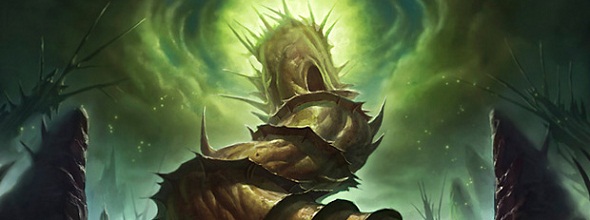
Mark Hinsz explores some uncharted opportunities Green Sun’s Zenith has in Legacy, pointing out silver bullets and worthy considerations that may help in those sigh-worthy matchups.
It hasn’t taken long for Green Sun’s Zenith to find its place in Legacy Aggro and Aggro-Control decks. You are sure to find people searching up Noble Hierarch, Tarmogoyf, Knight of the Reliquary and Dryad Arbor in nearly any Legacy tournament. The card has a maindeck home in NO RUG, NO Bant, Zoo, New Horizons, Rock decks, and Elves, to name only a few.
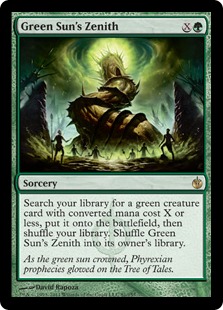 Turn 1 Green Sun’s Zenith for zero finding Dryad Arbor has even been a common play in the recent Modern Zoo lists—prompting it to be banned in Modern.
Turn 1 Green Sun’s Zenith for zero finding Dryad Arbor has even been a common play in the recent Modern Zoo lists—prompting it to be banned in Modern.
Aside from being both a mana accelerant/fixer and Fatty Finder(TM), the shuffle effect is so synergistic with other Legacy staples like Sensei’s Divining Top, Jace, the Mind Sculptor, Brainstorm, and Sylvan Library that it isn’t difficult to see why the card is so popular. Even if it gets countered, it probably grew your Tarmogoyf a little by adding a Sorcery to the Graveyard.
The card is nothing but upside.
Yet, with all these positive attributes, I giggle a little when I see decklists with no Green creatures as Zenith targets in the sideboards and no one-of’s maindeck. I took some time going through the volumes of Green creatures in Magic’s past—finding some Silver Bullets to counter common Legacy lynchpins. It should be noted that these findings can also be used in conjunction with other tutors such as Natural Order, Fauna Shaman, Worldly Tutor, Living Wish, Glittering Wish, Eladamri’s Call etc. etc.
I tailored this list towards Natural Order and Zoo decks, leaving most of the Elf cards alone.
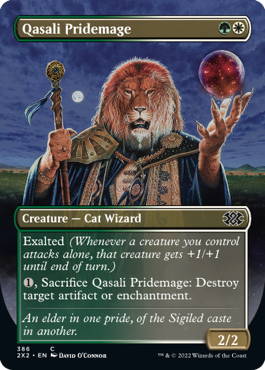
Not much to say here. If you are playing white, Pridemage is maindeckable in any case, so being able to dig one up with GSZ is just the cat’s meow. The creature blows up Aether Vials, Equipment, Artifact Creatures, and random Enchantments. It attacks like a Watchwolf, and cheers on others when they battle solo. Such a team player.
Honorable Mention: Trygon Predator. This flying beast can be a house against certain decks (Affinity, Enchantress), but I’ve found him to be a bit underwhelming. He doesn’t work so well if you are trying to beat an Umezawa’s Jitte, as they can just shrink him so he won’t trigger. He also doesn’t work very well vs. Vedalken Shackles, as they can just steal him before he gets a hit in. He’s better in Vintage, or if you don’t have access to white for Qasali Pridemage.
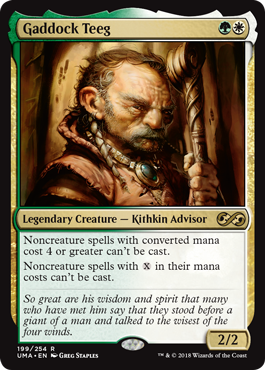
The green/white bane of combo. His presence is strange as he has the added backlash of turning off the very card you cast to find him. You are going to shuffle, shuffle, shuffle, and draw GSZ next turn – you know you will. I initially disliked playing GSZ to find Gaddock Teeg, as I was usually running Natural Order myself, but I think his maindeck inclusion in Channel Fireball/Brian Kibler’s Modern Zoo deck proves that as a one-of, Gaddock Teeg is perfectly fine. If you aren’t convinced, here is a list of Legacy staples he shuts down: Ad Nauseam, Tendrils of Agony, Force of Will, Goblin Charbelcher, Natural Order, Engineered Explosives, Hive Mind, Jace, the Mind Sculptor, Dread Return.
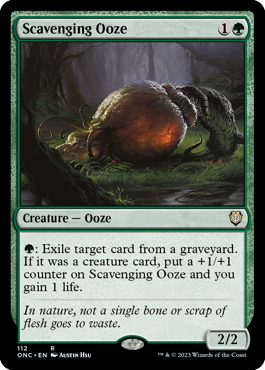
If you haven’t tried this card out, I strongly urge you to do so. I’ve been playing 1 maindeck in my Natural Order builds for some time now, and don’t plan to go back. When he is on the table, and you have open mana, he controls so many things – especially in Aggro-Control mirrors that rely on Tarmogoyf and Knight of the Reliquary to win. This card actively controls their size, and will often win in a straight up fight with either Tarmogoyf or Knight. He takes a small amount of work, but is often larger than Tarmogoyf after a turn or so (if you need him to be). Against Zoo and Merfolk, he can gain you the life to turn a race in your favor. Oh, and as a nice side-effect, he is a complete house vs. Reanimator, Life from the Loam, Dredge, and possibly Snapcaster Mage (if that becomes a thing). If you plan on using him, fetch green mana producers whenever possible, as he does get hungry for green. Most of my opponents have to read the card a couple times (especially when I say that I’ve gained life), but I think this card will become a staple in Green decks. The Ooze already has me thinking of him taking spots away from Tarmogoyf, and I can see that happening more and more if the right metagame appears.
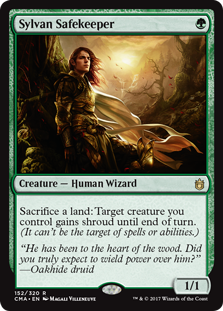
Olle Rade’s invitational card hasn’t seen much play in Legacy that I know of. His effect isn’t overly powerful – but he can fill a niche role much like Mother of Runes. At best you can find him with GSZ to blow a couple Knight of the Reliquary past removal in an alpha strike – sacrificing lands to grow the Knights. You can’t chain targets on the same knight, so resolve the first Safekeeper ability, then hold priority while saccing lands on other creatures, or Sylvan Safekeeper himself. Often they won’t see it coming and by the time GSZ has resolved, their Swords/Paths/Doom Blades are dead.
I have been including him in my sideboard for Merfolk and Goblins matchups. In my experience, the Natural Order player is often siding out the Natural Order package (4-5 slots) versus Merfolk, as it can be too slow. The matchup then becomes about two things: Islandwalking, and Submerge. Olle protects you from both. Naive Merfolk Scrubs(TM) will unknowingly swim their fishes into the desert, to be eaten alive by gigantic Lurghoyfs and Knights. Naive Merfolk Scrub (TM) translation: I will sacrifice all my islands when you try to alpha strike me with Islandwalkers. With Olle on the table, you also don’t have to fear a Submerge in response to fetchland – or any other time. When facing Goblins, Tarmogoyf is easily their biggest problem, and they need to rely on either a cycled Gempalm Incinerator, or a Stingscourger to get past the blockade. Olle again shuts down both of these outs.
I’ll also try to raw-dog Sylvan Safekeeper alongside Gaddock Teeg vs. Combo, as they’re only going off if they bounce Gaddock Teeg somehow.
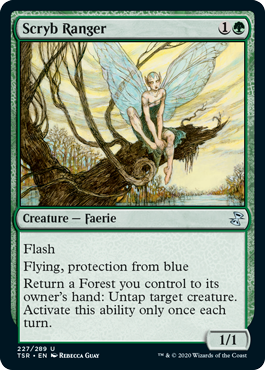
This Faerie plays much the same role as Sylvan Safekeeper. The Protection from Blue ability naturally lends itself as a foil to Merfolk. Bounce a Tropical Island to avoid Islandwalk. Untap a Tarmogoyf to block. Untap a Knight of the Reliquary for additional activations (and block). Untap that Noble Hierarch for the white mana you need for your Swords… etc. etc. The card is tricky, but I would advise a closer look at it, and his flying ability can become much more attractive if you are running equipment.
SEE ALSO: Quirion Ranger
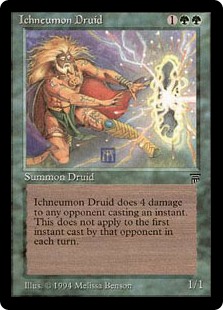
Go ahead, Look it up. I imagine the banning of Mental Misstep in Legacy will cause a resurgence of High Tide combo for anyone who owns Candelabra of Tawnos. High Tide runs on a plethora of instants to fuel its namesake (Instant) and combo off. Ichneumon Druid isn’t awful vs. Ad Nauseum either. The damage should reduce their ability to draw cards off of Ad Nauseum, or prevent them from using a number of Dark Rituals/Cabal Rituals to re-ramp mana into Tendrils of Agony. Quick combo decks are another matchup where Natural Order players may be siding out their NO package. Ichneumon Druid is another threat, fetchable with GSZ, to fight those decks from the sideboard.
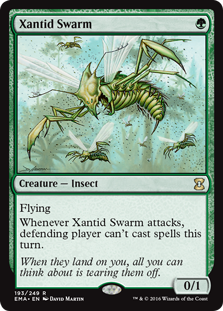
Odds are good that if you play Green Sun’s Zenith, you are also running Natural Order. Natural Order has a huge upside but can be a complete blowout if countered. Xantid Swarm, however, can protect you from that, as well as any other spells you are looking to cast. You can happily sacrifice the Xantid Swarm to Natural Order without fear of counterspells: the effect lasts until end of turn, whether the Xantid Swarm is in play or not.
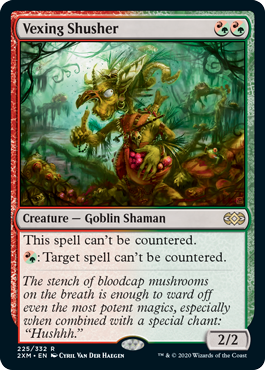
One of the benefits of Green Sun’s Zenith is being able to tutor for creatures that are pretty bad in multiples (Gaddock Teeg). Vexing Shusher falls into this category as well and fits into a similar space as Xantid Swarm. It costs more but is uncounterable and has the added benefit of protecting YOUR counterspells and removal on THEIR turn. I find this guy more effective in Bant builds, as decks representing red spells (RUG) will have Hydroblasts and Blue Elemental Blasts sideboarded against them, which can easily kill off Shusher.
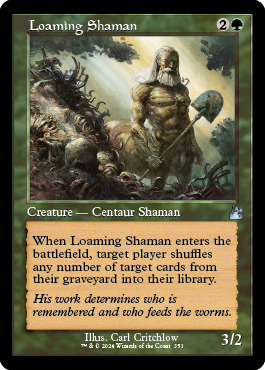
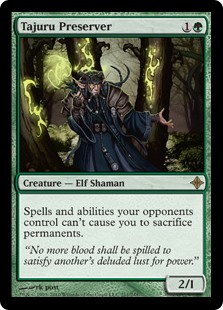
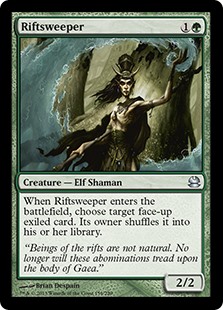
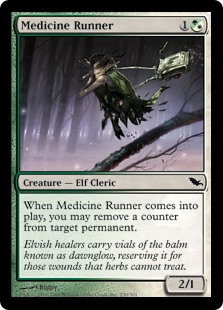
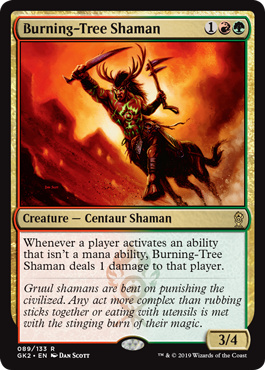
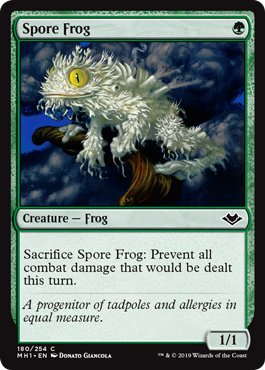
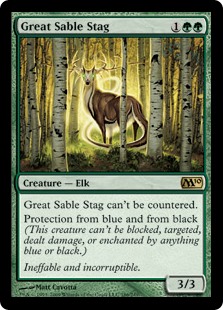
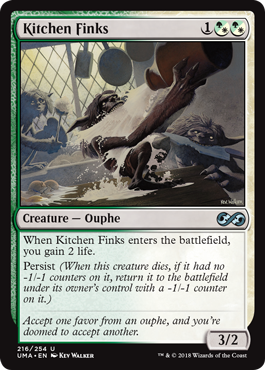
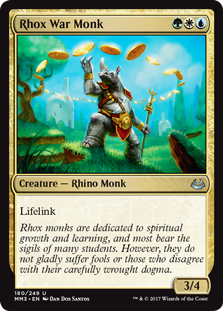
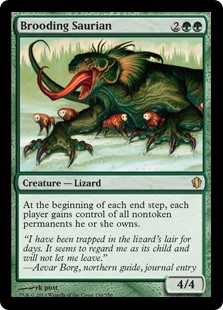
Loaming Shaman: One-shot graveyard hate in the form of a Green Creature.
Tajuru Preserver: Fights Edict effects, Show and Tell’d Eldrazi, Devastating Dreams.
Riftsweeper: Suspended Ancestral Vision. Bonus: Get back Progenitus after pitching it to Force of Will.
Medicine Runner: when you can’t beat Chalice of the Void on one (Qasali Pridemage works too).
Burning-Tree Shaman: Can fight Cephalid Breakfast combo.
Spore Frog: Fog on a frog.
Great Sable Stag: Fights Merfolk and Batterskulls (Germ Tokens).
Kitchen Finks/Rhox War Monk: Lifegain.
Brooding Saurian: anti Shackles, Sower of Temptation.
Find the original post here.

Mark Hinsz explores some uncharted opportunities Green Sun’s Zenith has in Legacy, pointing out silver bullets and worthy considerations that may help in those sigh-worthy matchups.
It hasn’t taken long for Green Sun’s Zenith to find its place in Legacy Aggro and Aggro-Control decks. You are sure to find people searching up Noble Hierarch, Tarmogoyf, Knight of the Reliquary and Dryad Arbor in nearly any Legacy tournament. The card has a maindeck home in NO RUG, NO Bant, Zoo, New Horizons, Rock decks, and Elves, to name only a few.
 Turn 1 Green Sun’s Zenith for zero finding Dryad Arbor has even been a common play in the recent Modern Zoo lists—prompting it to be banned in Modern.
Turn 1 Green Sun’s Zenith for zero finding Dryad Arbor has even been a common play in the recent Modern Zoo lists—prompting it to be banned in Modern.Aside from being both a mana accelerant/fixer and Fatty Finder(TM), the shuffle effect is so synergistic with other Legacy staples like Sensei’s Divining Top, Jace, the Mind Sculptor, Brainstorm, and Sylvan Library that it isn’t difficult to see why the card is so popular. Even if it gets countered, it probably grew your Tarmogoyf a little by adding a Sorcery to the Graveyard.
The card is nothing but upside.
Yet, with all these positive attributes, I giggle a little when I see decklists with no Green creatures as Zenith targets in the sideboards and no one-of’s maindeck. I took some time going through the volumes of Green creatures in Magic’s past—finding some Silver Bullets to counter common Legacy lynchpins. It should be noted that these findings can also be used in conjunction with other tutors such as Natural Order, Fauna Shaman, Worldly Tutor, Living Wish, Glittering Wish, Eladamri’s Call etc. etc.
I tailored this list towards Natural Order and Zoo decks, leaving most of the Elf cards alone.
OBVIOUS GSZ TARGETS
#1: Qasali Pridemage
Not much to say here. If you are playing white, Pridemage is maindeckable in any case, so being able to dig one up with GSZ is just the cat’s meow. The creature blows up Aether Vials, Equipment, Artifact Creatures, and random Enchantments. It attacks like a Watchwolf, and cheers on others when they battle solo. Such a team player.
Honorable Mention: Trygon Predator. This flying beast can be a house against certain decks (Affinity, Enchantress), but I’ve found him to be a bit underwhelming. He doesn’t work so well if you are trying to beat an Umezawa’s Jitte, as they can just shrink him so he won’t trigger. He also doesn’t work very well vs. Vedalken Shackles, as they can just steal him before he gets a hit in. He’s better in Vintage, or if you don’t have access to white for Qasali Pridemage.
#2: Gaddock Teeg
The green/white bane of combo. His presence is strange as he has the added backlash of turning off the very card you cast to find him. You are going to shuffle, shuffle, shuffle, and draw GSZ next turn – you know you will. I initially disliked playing GSZ to find Gaddock Teeg, as I was usually running Natural Order myself, but I think his maindeck inclusion in Channel Fireball/Brian Kibler’s Modern Zoo deck proves that as a one-of, Gaddock Teeg is perfectly fine. If you aren’t convinced, here is a list of Legacy staples he shuts down: Ad Nauseam, Tendrils of Agony, Force of Will, Goblin Charbelcher, Natural Order, Engineered Explosives, Hive Mind, Jace, the Mind Sculptor, Dread Return.
NOT SO OBVIOUS GSZ TARGETS
#1: Scavenging Ooze
If you haven’t tried this card out, I strongly urge you to do so. I’ve been playing 1 maindeck in my Natural Order builds for some time now, and don’t plan to go back. When he is on the table, and you have open mana, he controls so many things – especially in Aggro-Control mirrors that rely on Tarmogoyf and Knight of the Reliquary to win. This card actively controls their size, and will often win in a straight up fight with either Tarmogoyf or Knight. He takes a small amount of work, but is often larger than Tarmogoyf after a turn or so (if you need him to be). Against Zoo and Merfolk, he can gain you the life to turn a race in your favor. Oh, and as a nice side-effect, he is a complete house vs. Reanimator, Life from the Loam, Dredge, and possibly Snapcaster Mage (if that becomes a thing). If you plan on using him, fetch green mana producers whenever possible, as he does get hungry for green. Most of my opponents have to read the card a couple times (especially when I say that I’ve gained life), but I think this card will become a staple in Green decks. The Ooze already has me thinking of him taking spots away from Tarmogoyf, and I can see that happening more and more if the right metagame appears.
#2: Sylvan Safekeeper
Olle Rade’s invitational card hasn’t seen much play in Legacy that I know of. His effect isn’t overly powerful – but he can fill a niche role much like Mother of Runes. At best you can find him with GSZ to blow a couple Knight of the Reliquary past removal in an alpha strike – sacrificing lands to grow the Knights. You can’t chain targets on the same knight, so resolve the first Safekeeper ability, then hold priority while saccing lands on other creatures, or Sylvan Safekeeper himself. Often they won’t see it coming and by the time GSZ has resolved, their Swords/Paths/Doom Blades are dead.
I have been including him in my sideboard for Merfolk and Goblins matchups. In my experience, the Natural Order player is often siding out the Natural Order package (4-5 slots) versus Merfolk, as it can be too slow. The matchup then becomes about two things: Islandwalking, and Submerge. Olle protects you from both. Naive Merfolk Scrubs(TM) will unknowingly swim their fishes into the desert, to be eaten alive by gigantic Lurghoyfs and Knights. Naive Merfolk Scrub (TM) translation: I will sacrifice all my islands when you try to alpha strike me with Islandwalkers. With Olle on the table, you also don’t have to fear a Submerge in response to fetchland – or any other time. When facing Goblins, Tarmogoyf is easily their biggest problem, and they need to rely on either a cycled Gempalm Incinerator, or a Stingscourger to get past the blockade. Olle again shuts down both of these outs.
I’ll also try to raw-dog Sylvan Safekeeper alongside Gaddock Teeg vs. Combo, as they’re only going off if they bounce Gaddock Teeg somehow.
#3: Scryb Ranger
This Faerie plays much the same role as Sylvan Safekeeper. The Protection from Blue ability naturally lends itself as a foil to Merfolk. Bounce a Tropical Island to avoid Islandwalk. Untap a Tarmogoyf to block. Untap a Knight of the Reliquary for additional activations (and block). Untap that Noble Hierarch for the white mana you need for your Swords… etc. etc. The card is tricky, but I would advise a closer look at it, and his flying ability can become much more attractive if you are running equipment.
SEE ALSO: Quirion Ranger
SILVER BULLET SIDEBOARD GSZ TARGETS
#1: Ichneumon Druid
Go ahead, Look it up. I imagine the banning of Mental Misstep in Legacy will cause a resurgence of High Tide combo for anyone who owns Candelabra of Tawnos. High Tide runs on a plethora of instants to fuel its namesake (Instant) and combo off. Ichneumon Druid isn’t awful vs. Ad Nauseum either. The damage should reduce their ability to draw cards off of Ad Nauseum, or prevent them from using a number of Dark Rituals/Cabal Rituals to re-ramp mana into Tendrils of Agony. Quick combo decks are another matchup where Natural Order players may be siding out their NO package. Ichneumon Druid is another threat, fetchable with GSZ, to fight those decks from the sideboard.
#2: Xantid Swarm
Odds are good that if you play Green Sun’s Zenith, you are also running Natural Order. Natural Order has a huge upside but can be a complete blowout if countered. Xantid Swarm, however, can protect you from that, as well as any other spells you are looking to cast. You can happily sacrifice the Xantid Swarm to Natural Order without fear of counterspells: the effect lasts until end of turn, whether the Xantid Swarm is in play or not.
#3: Vexing Shusher
One of the benefits of Green Sun’s Zenith is being able to tutor for creatures that are pretty bad in multiples (Gaddock Teeg). Vexing Shusher falls into this category as well and fits into a similar space as Xantid Swarm. It costs more but is uncounterable and has the added benefit of protecting YOUR counterspells and removal on THEIR turn. I find this guy more effective in Bant builds, as decks representing red spells (RUG) will have Hydroblasts and Blue Elemental Blasts sideboarded against them, which can easily kill off Shusher.
NARROW CHANCE OF SEEING PLAY (albeit possible) GSZ TARGETS
Loaming Shaman: One-shot graveyard hate in the form of a Green Creature.
Tajuru Preserver: Fights Edict effects, Show and Tell’d Eldrazi, Devastating Dreams.
Riftsweeper: Suspended Ancestral Vision. Bonus: Get back Progenitus after pitching it to Force of Will.
Medicine Runner: when you can’t beat Chalice of the Void on one (Qasali Pridemage works too).
Burning-Tree Shaman: Can fight Cephalid Breakfast combo.
Spore Frog: Fog on a frog.
Great Sable Stag: Fights Merfolk and Batterskulls (Germ Tokens).
Kitchen Finks/Rhox War Monk: Lifegain.
Brooding Saurian: anti Shackles, Sower of Temptation.
Find the original post here.
Subscribe to:
Comments (Atom)


